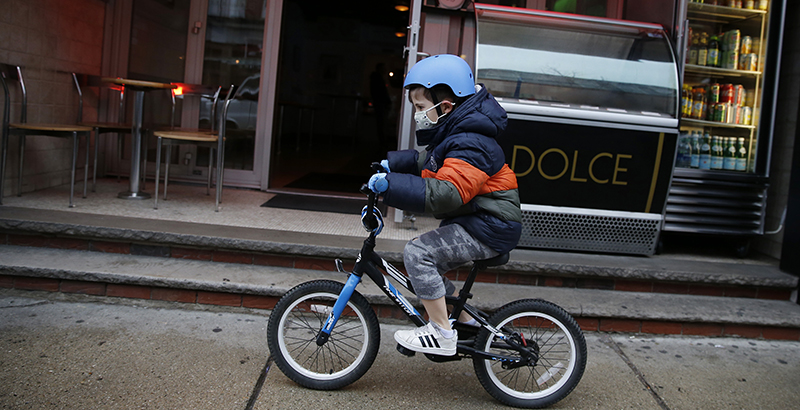Coronavirus Must-Reads for Schools: A $2 Trillion Stimulus Ignores ‘Digital Divide,’ More Cities Launch Remote Learning Plans, New Concerns for Students With Disabilities & More

This is a special edition of EduClips, our recurring roundup of top education headlines from America’s 15 largest school districts, where more than 4 million students across 10 states typically attend class every day. See our full EduClips archive right here.
It may have taken a forced quarantine brought on by a deadly pandemic to do it, but the nation’s eyes have finally turned to the inequities facing online instruction. Whereas early coverage of the crisis spotlighted harried teachers and parents suddenly turned into homeschoolers, the focus has turned to the large numbers of students and families who lack any access to Wi-Fi at home. Whether you call it the “digital divide” or the “homework gap,” the issue is crucial now that the pandemic has closed more than 124,000 school buildings, leaving more than 55 million children without face-to-face classroom instruction.
In a rare education-focused editorial, headlined “Locked Out of the Virtual Classroom,” The New York Times put the matter in stark terms: “Internet-savvy school systems that serve connected populations appear to be moving ahead relatively smoothly with the new order of business. At the same time, some districts that lack infrastructure and serve heavily poor populations have given up altogether on remote learning. Still others are hesitant to pursue online instruction out of fear they might be hauled into court for offering course materials to which broadband-deprived families cannot gain access.”
The problems are urban: New York City, the nation’s largest school district, is struggling to acquire internet-connected devices for the estimated 300,000 students who lack them. But they’re also rural: In Culberson County, Texas, about a two-hour drive from El Paso, just 4 percent of the population uses the internet at broadband speeds necessary for online instructional tools that rely on streaming, according to Microsoft. A new analysis of 46 districts, released by the Center on Reinventing Public Education, found that only a third had plans to deliver computers to students and none had figured out how to ensure that “100 percent of students have a … device and reliable, long-term access to the internet.”
Thus far, a concerted federal push to address the issue has been lacking. The same day the Times published its editorial, President Trump signed the largest stimulus package in American history. Despite offering $13.5 billion for K-12 schools, the bill did not heed the call to provide specific relief for the nation’s online infrastructure. Advocates and politicians are still hopeful that the idea could be resurrected in a future broadband stimulus bill. “K-12 leaders have been calling on Congress to address these problems for years,” said Reg Leichty, a founder and partner at Foresight Law + Policy. “Low-income students are at a disadvantage if they don’t have broadband at home. The public has awoken to this issue all of a sudden because it’s not just poor kids, it’s all kids.”
Top Stories
Social Distancing — ‘This is a Health Hazard’: New Jersey Parents Stand Together in Long Lines to Get School Materials for Their Children (Read at USA Today)
Recession — What the Great Recession Tells Us About the Pandemic Downturn to Come: Expect Declining Student Performance, Widening Achievement Gaps (Read at The74Million.org)
Attendance —15,000 L.A. High School Students Are AWOL Online, 40,000 Fail to Check In Daily Amid Coronavirus Closures (Read at the Los Angeles Times)
Child Abuse — Out of Sight, Child Abuse in Texas Thought to Be on the Rise (Read at The Texas Tribune)
Liberty University — What’s It Like on One of the Only University Campuses Still Open in the U.S.? (Read at ProPublica)
‘Social Distance’ Learning
For Better or Worse, Coronavirus Puts Cyber Charters in the Spotlight (Read at EdWeek)
No Online Learning? With Schools Closed from Coronavirus, These Teachers Air TV Lessons (Read at USA Today)
Here’s a First Look at Chicago’s New Remote Learning Plan, Which Will Include 100,000 Devices for Students (Read at Chalkbeat)
While Educators Promote Online Learning as Coronavirus Spreads, Some Illinois Students Aren’t Equipped With the Broadband to Even Notice (Read at ProPublica)
Broward Schools Online Education Platform Crashes on First Day (Read at Palm Beach Politics)
Parents and Families
Parents Created Kid Schedules After Coronavirus Closed Schools. That Didn’t Last. (Read at The Wall Street Journal)
I Home-Schooled My Kids for 3 Years. Here’s What Parents Need to Know Now (Read at HuffPost)
Tips for Homeschooling During Coronavirus (Read at NPR)
Current Events, Science, Politics — National Geographic Opens Up Learn-at-Home Resources for Grades K-12. 2 Students Check Them Out (Read at The74Million.org)
Educators
When Teaching and Parenting Collide: As Schools Shift Online, Many Educators Manage Two Roles (Read at Chalkbeat)
Many Substitute Teachers Are Going Without Pay During School Closures (Read at EdWeek)
Teachers of Newcomer Students Try to Keep Them Connected as Schools Close, Routines Shift (Read at Chalkbeat)
Special Education
Fierce Debate as DeVos Weighs Schools’ Obligations to Students With Disabilities (Read at EdWeek)
‘It Feels a Little Hopeless’: Parents of Kids With Disabilities Worry Coronavirus Quarantine Will Mean Regression (Read at The Hechinger Report)
Students With Disabilities Could Lose With COVID-19 Stimulus Package (Read at The Hill)
As Schools Close to Coronavirus, Special Educators Turn to Tele-Therapy (Read at EdWeek)
Equity and Activism
She’s 10, Homeless and Eager to Learn. But She Has No Internet. (Read at The New York Times)
Detroit to Increase Meals Sites for Students, Filling Gap Left When the District Scaled Back (Read at Chalkbeat)
Essays and Reflections
Rotherham: Why America’s Schools Should Stay Open This Summer (Read at The74Million.org)
COVID-19 Is Exposing the Gaps in Our Education System. Let’s Start Fixing Them (Read at Education Week)
Remote Learning Can Be More Than a Bandage (Read at Real Clear Education)
Can Schools Avert the Coronavirus Cliff? (Read at Flypaper)
Pondiscio: Studying Current Events Boosts Literacy and Civic Engagement. And It Probably Fits Into Your Learning-From-Home Routine (Read at The74Million.org)
QuotED
“The first question is how do we survive between now and the end of June. But we really need to start talking about what this looks like a year from now.” —Michael K. Barbour, education professor at Touro University California and an expert on virtual learning. (Read at Education Week)
“I think we have a responsibility to our students — who paid to be here, who want to be here, who love it here — to give them the ability to be with their friends, to continue their studies, enjoy the room and board they’ve already paid for and to not interrupt their college life.” —Liberty University President Jerry Falwell Jr., whose school is staying open during the coronavirus pandemic. (Read at ProPublica)
“If, next year, the kids can’t go back to school, and on top of that, school budgets are being cut by 10 or 15 percent, how those schools are going to implement the virtual learning systems when they’ve had to lay off a significant portion of their teacher labor force is a completely unknown quantity. That has never happened before — kids having to work from home, and schools having to deal with massive layoffs at the same time.” —Pennsylvania State University professor Kenneth Shores, on the coming economic downturn. (Read at The74Million.org)
“We know that additional strain and stress on families during this crisis puts children at an increased risk of abuse.” —Sophie Phillips, chief executive officer of the advocacy organization TexProtects. (Read at The Texas Tribune)
“[Betsy DeVos’s] assumption is that everybody sits with the same opportunities with the internet, with all the resources supporting technology, and thinks everyone is well supported with access. And that is just so narrow-minded to think that everybody is in that same shape.” —Troy Kilzer, director of schools for rural Chester County Schools in southwest Tennessee. (Read at Education Dive)
Get stories like these delivered straight to your inbox. Sign up for The 74 Newsletter

;)
